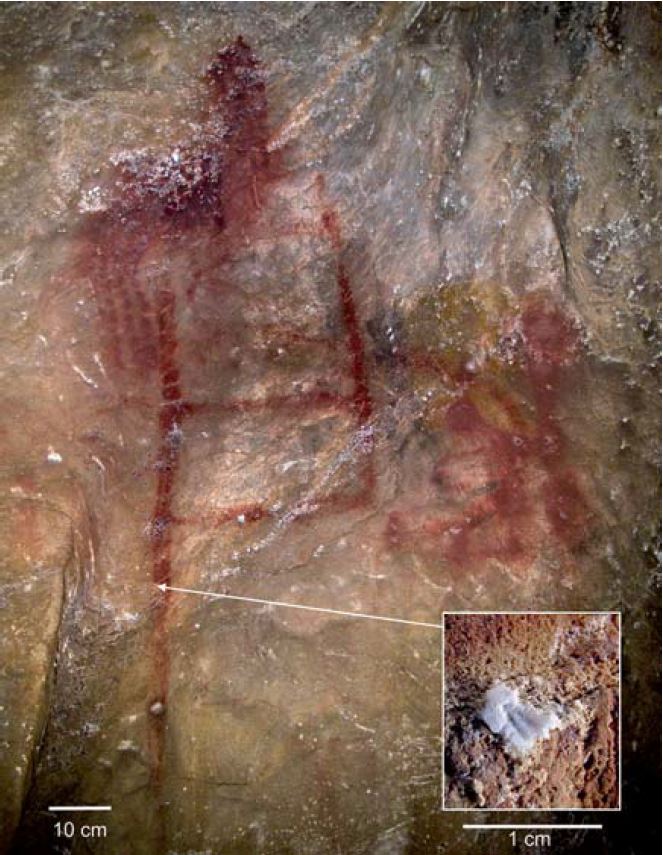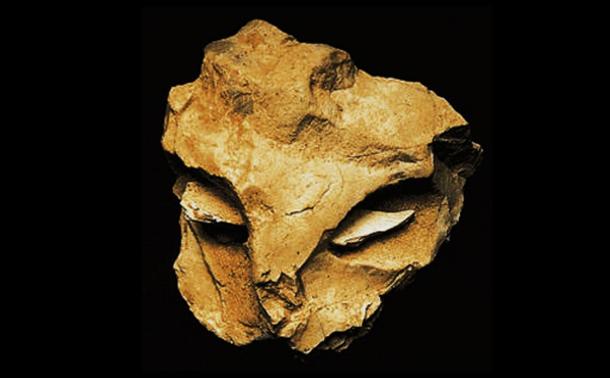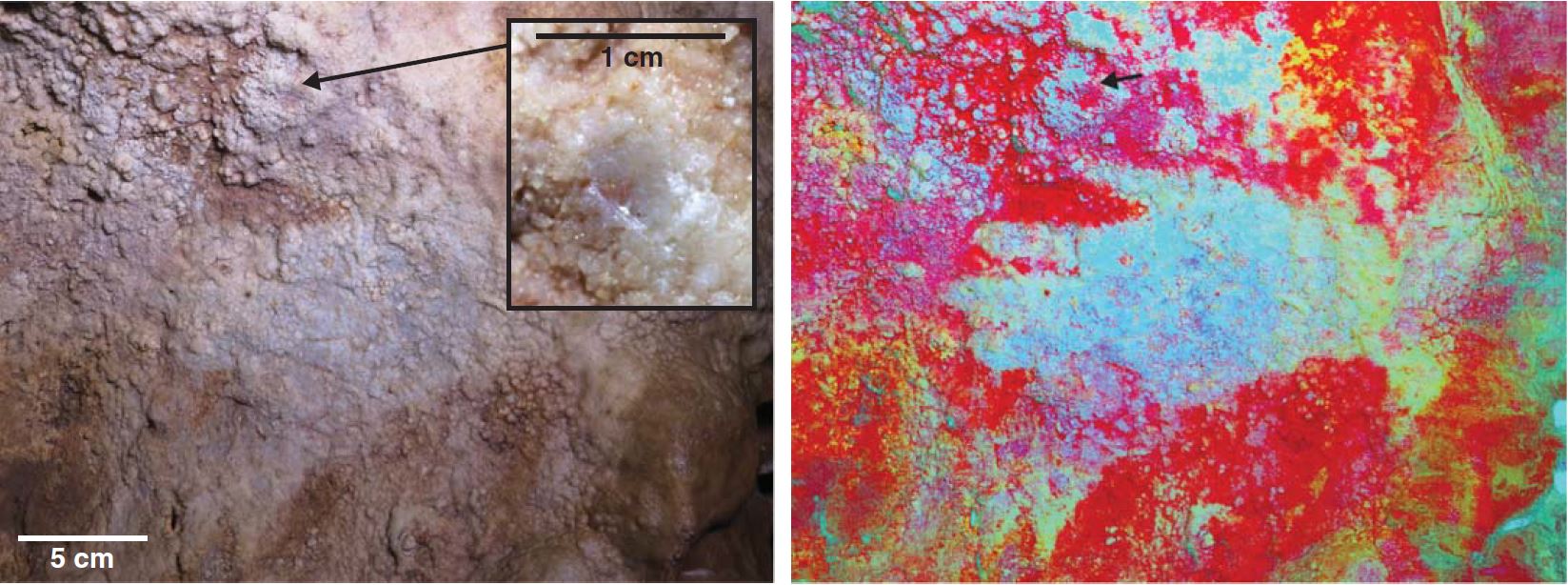
(Inset) Crust sampled and analysed for a minimum age (64.8 ka),
which constrains the age of the red line.
Most of the popular coverage of the recent announcements about the possible Neanderthal link to parietal art in Spanish caves has, as usual, been focussing on the old paradigm of their being much less “advanced” or “intelligent” than their H. Sapiens successors in Europe.
This is a view that has taken something of a battering over the past few years, but has yet to be shifted from the general public. The pushback can be said to have started with the work of João Zilhão and others who argued back in 2000 that the morphology of certain fossil finds, again from Spain, indicated a degree of hybridisation between Neanderthals and anatomically modern humans (AMH). This work was greeted with enormous doubt by other workers in the field of Human origins but has since been validated by DNA analyses and it is now an accepted fact that modern H. sap., except in Africa, carry measurable quantities of Neanderthal DNA.
Evidence has also been slowly mounting that our ancient cousins may also have been capable of abstract thought and actions which have previously been regarded as ours alone. The earliest published example is probably the ‘face’ found in the cave of La Roche-Cotard in France in 1975 and published in Antiquity by Lorblanchet and Marquet in 2003. This object consists of a piece of worked flint which seems to have been trimmed to more resemble a face and into which a second piece of flint has been inserted to represent eyes.

In 2014, work from Gorham’s Cave, in Gibraltar described an abstract engraving found on the cave floor which was previously covered by dated Mousterian sediments and thus over 39,000 years old. Although found in close proximity to Mousterian deposits, this find has not been accepted as unequivocal evidence of Neanderthal authorship as modern Humans had certainly arrived in Europe by this time.
The next exhibit in building this case for the Neanderthals has to be the discoveries in Bruniquel, previously reported on by Darkness Below . The structures in this cave have been accepted as the work of Neanderthals. They have been dated to 176,000 years ago, long before modern Humans arrived in Europe. However, we do not know anything about why they were constructed so deep into the cave.
So, what does the latest batch of data tell us? Two papers were published in Science last week: Symbolic use of marine shells and mineral pigments by Iberian Neandertals 115,000 years ago and U-Th dating of carbonate crusts reveals Neandertal origin of Iberian cave art.
The first paper describes the analysis of a deposit in a cave, the Cueva de los Aviones, Cartagena, in the Murcia region of Spain. The claim that the deposit has a minimum age of around 115,000 years ago is based on the dating of a flowstone which caps a (presumed) earlier deposit containing materials, complex pigments and pierced shells, that can be accepted as proxies for symbolic behaviour. Accepting this is difficult, for two reasons. Firstly, 14C dates have previously been obtained on limpet shells from this deposit. The paper argues that for a number of reasons the dates obtained, 45-50 ka, might be deemed unreliable, possibly only minimum ages, and, secondly, although the date on the stalagmite is correct, the deposit beneath it cannot be certainly said to pre-date it. Given the situation it remains possible that an original deposit may have been eroded, possibly by wave action, the cave is a sea cave and the base of the deposit is currently at sea level, and later replaced by the present deposit. This is a circumstance which will be familiar to those who have dug in caves so close to sea level. Dr Rebecca Wragg Sykes told Darkness Below “Neanderthals perforating shells and making pigment mixes before 115 Ka is significant because it would be older than the current comparable record in the Middle Stone Age, which is claimed as the roots of cognitive modernity. However we need clearer evidence that the dated flowstone formed on top of the archaeological layers, and is not a hanging remnant from an earlier phase of cave sedimentation”.

(Left) Original photo. The inset shows where the overlying carbonate was sampled for MAL 13.
(Right) Same picture after application of the DStretch software
The latter is concerned with directly dating thin flowstone crusts which overlay motifs in separate caves a red linear motif in the cave of La Pasiega in Cabtabria, part of the Monte Castillo World Heritage site which also includes the caves of El Castillo, Las Chimenas and Las Monedas. a hand stencil in the Maltravieso cave in Extramadura, and some red painted stal curtains in Ardales cave in Andalucia. Similar work was reported in 2012 on a red disc from El Castillo and gave a minimum age of 40.8 ka but this is inconclusive as it could be attributed to Cantabria’s first modern Humans. However, the latest work gives a minimum age of 64.8 ka for the red line in La Pasiega and one of 66.7 ka for the hand stencil in Maltravieso. These dates are some 20 ka before the first H. sap. arrived in Europe. Dr. Wragg Sykes said “Not only is this old enough to be (virtually) certain it’s Neanderthals, but there’s multiple sorts of artistic behaviour documented; in the hand negative, we see something pretty close to a representational image, even if it’s not a drawing.”
The verdict on the latest research must therefore be optimistic but mixed. The jury is surely no longer out on Neanderthal ability to use pigments in these ways, but is filing back in to the court room to give its judgement. However, this is tempered by the need to remain cautious in the face of extraordinary claims.
